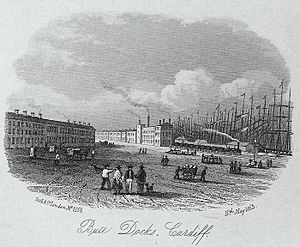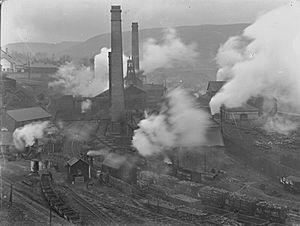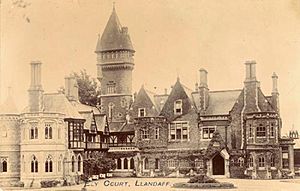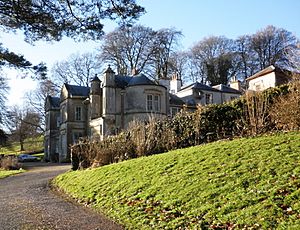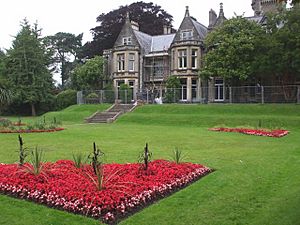James Harvey Insole facts for kids
Quick facts for kids
James Harvey Insole
|
|
|---|---|
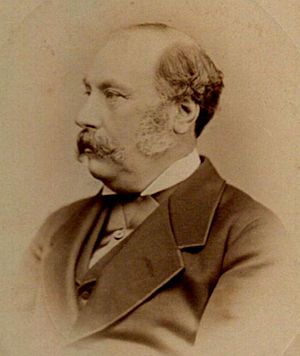 |
|
| Born | 30 April 1821 Worcester, Worcestershire, England
|
| Died | 20 January 1901 (aged 79) Llandaff, Glamorgan, Wales
|
| Burial place | Llandaff Cathedral, Llandaff, Glamorgan, Wales |
| Occupation | Colliery proprietor |
| Known for | Consolidation and development of the family's extensive South Wales coal business; development of Cardiff, Wales, as a coal shipping port; Insole Court |
| Spouse(s) | Mary Ann Jones (m. 1843–1882); Marian Louisa Carey née Eagle (m. 1890–1901) |
| Parent(s) | George Insole |
James Harvey Insole (born 30 April 1821 – died 20 January 1901) was an important English businessman. He took over and grew his father's large coal mining and shipping business in South Wales.
In 1842, James became a partner in his father's company. They worked together to lease and restart the Cymmer coal mines in 1844. They also expanded their sales to other parts of the country and even overseas. When his father passed away in 1851, James took full control of the company.
A terrible accident happened in 1856 at the Cymmer mine. An underground gas explosion killed many people. Later, in 1862, Insole bought another mine called Abergorki. His company kept growing, digging up rich steam coal from the Rhondda Valley. By the end of the 1800s, his company was one of the main exporters of coal from South Wales. The company continued to operate until 1940.
James Insole also played a big part in making Cardiff, Wales, a major port for shipping coal. He helped improve how coal was loaded onto ships and supported building the new dock at Penarth, which opened in 1865.
Besides his business, Insole had many public roles. He served as a magistrate (a type of local judge) for both Cardiff and Glamorgan. He was also the first president of the Cardiff Chamber of Commerce. He and his company gave a lot of money to help public causes like education and health.
Today, Insole's legacy lives on through his grand Victorian house, Ely Court, in Llandaff, Wales. It is now known as Insole Court and is a popular place for community activities and events.
Contents
Early Life and Family
James Harvey Insole was born on April 30, 1821, in Worcester, England. He was baptised just two days later. He was the second child and oldest son of George and Mary Insole. When James was very young, his father worked as a carpenter in Worcester.
In 1828, his family moved to Cardiff. There, James's father started building his coal mining and shipping business. James went to schools in Cardiff and Melksham, Wiltshire.
In 1842, when James turned 21, he received money from his father's wealthy uncle. In 1843, James married Mary Ann Jones. They had three children: two sons and a daughter. The family lived in Cardiff, right next door to James's parents, until 1852.
Building a Coal Empire
In 1842, James's father made him a partner in the business, which was named George Insole & Son. At first, they were working at the Maesmawr pit, but its coal was running out. So, in 1844, they leased and restarted the bituminous coal mines at Cymmer. In 1848, they built 36 ovens to make coke for the Taff Vale Railway Company.
Insole also suggested that the Taff Vale Railway Company work with Lord Bute to build special coal loading areas called "staiths" at the Cardiff Bute Dock (West). In 1848, the Insoles were the first to load a ship at Cardiff using these new "mechanical appliances."
Until 1847, the Insoles mostly sold coal to nearby coastal towns in the Bristol Channel and to ports in Cornwall and Ireland. Later, they started selling to French markets like Brest and Nantes. By 1849, they were shipping coal even further away, to the Mediterranean, the Near East, South America, and even as far as Chile and Singapore.
James took full control of the business when his father died in 1851. He was 29 years old and known as a very driven businessman. That year, he started digging the Upper Cymmer Colliery, and then the New Cymmer Colliery in 1855.
The Cymmer Mine Disaster
The Crimean War made 1855 a very busy year for coal. Insole began digging a lot at his Cymmer Old Pit. But in the early morning of July 15, 1856, a gas explosion happened underground. This terrible accident killed 114 men and boys. Thirty-four of them were under 16, and fifteen were under 12. It was one of the worst mining disasters in the country's history. The local communities were deeply affected, as many families lost their main providers.
An investigation found that the explosion was caused by poor mine ventilation and the use of open flames underground. This happened despite warnings from the mine inspector. The inspector said the explosion was due to the people in charge not taking basic safety steps.
James Insole said he wasn't involved in the daily management of the mine. He claimed he didn't know about ventilation problems or safety rules. He was cleared of blame after legal proceedings. However, some people criticized his statements, especially when he later changed his story about his mine manager's skills.
Historian E. D. Lewis wrote that the disaster was a direct result of how quickly and carelessly the Cymmer Old Pit was developed by James Harvey Insole. He also stated that even if the laws at the time weren't enough to punish those responsible, there was no doubt about the moral responsibility of the owner and officials.
Insole gave £500 (which was a lot of money back then) to a fund to help the widows and orphans of the miners who died. He also paid for the 30 graves at the Cymmer Chapel.
After the Disaster
The Cymmer Old Pit continued to operate until 1939. To make sure he had enough steam coal, Insole bought the Abergorki Level mine in 1862. In 1865, the new Penarth Dock opened, and Insole was one of its first directors. This new dock competed with the busy Bute Docks. The Cymmer mine was made deeper between 1875 and 1877 to reach more rich coal seams. By the end of the century, Insole's company was again a top exporter of South Wales steam coal. The company stayed in business until 1940. Although he still had an interest in the industry, Insole mostly retired from running his company by 1875.
Becoming a Gentleman
| Coat of arms of James Harvey Insole |
|
|---|---|
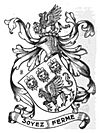 |
|
| Adopted | 15 April 1872 (H. Coll.) |
| Crest | Upon a wreath of the colours, a griffin passant or, charged on the body with two pheons and resting the dexter claw on a leopard's face jessant-de-lys azure |
| Blazon | Azure, a griffin passant, in chief three leopards' faces jessant-de-lys or |
| Motto | Soyez Ferme (Be Steadfast) |
| Other elements | Mantling azure and or Livery blue, with yellow facings |
James Insole used his wealth to gain a higher social standing. After his father died in 1851, Insole moved his family to Llandaff, a healthier and more fashionable village near Cardiff. In 1855, he started building Ely Court, a large, fancy house with a big garden and an impressive driveway. Over the next 25 years, Insole bought much of the land around his house to create a huge park. In the 1870s, the house was made even bigger and more decorative in a style similar to William Burges's work on Cardiff Castle.
Insole already owned several estates in Glamorganshire and land in Cardiff. He wanted to build a family legacy of land ownership. In 1872, he received a special family crest and shield from the College of Heralds. Three years later, he bought the large Luxborough estate in Somerset. This estate included a hunting lodge, many farms, cottages, and forests. This allowed Insole to call himself "Lord of the Manors of Luxborough and Withiel Florey." In 1878, he was listed in a famous book about important people.
Insole loved gardening. He and his gardeners often entered plants in flower shows and won awards against other wealthy gentlemen. He spent over 40 years improving his gardens and estates. He was very knowledgeable about plants and farming and was always ready to try new things in his garden.
In 1882, Ely Court was described as the "leading residence in the locality." Insole also collected paintings and valuable art objects. In 1881, some of his bronzes, silver items, and paintings were shown at an exhibition in Cardiff.
Giving Back to the Community
James Insole and his company often appeared on lists of people who donated to good causes. In 1882, he promised £1,000 for the new University College of South Wales and Monmouthshire in Cardiff. He also provided a £25 scholarship each year for a Cardiff student to study further. In 1883, a ward at the Cardiff Royal Infirmary was renamed the Insole Ward because he donated £1,000.
In 1890, Insole's company gave £250 over five years to help fund the new University College engineering department. From 1892, the J. H. Insole scholarship gave £25 a year for three years to support a student studying mining.
Although he was connected to a different church as a boy, Insole was a strong supporter of the Church of England as an adult. He also helped fund other church building projects. His tenants knew him as a generous supporter of the local church at Withiel Florey.
Community Roles
James Insole held many important roles in his community:
- Cardiff street commissioner (1848)
- Justice of the Peace and magistrate for Cardiff (1856)
- Land tax commissioner for Glamorgan (1856/1857)
- Vice consul to Spain at Cardiff (1858)
- First president of the Cardiff Chamber of Commerce (1866)
- Magistrate for Glamorgan (1867)
- Member of the Pall Mall Club
He was also a director for several companies, including:
- Penarth Harbour, Dock and Railway Company
- Ely Valley Railway Company
- Patent Fuel Works
- Cardiff Hotel Company
- Cardiff Baths Company
Later Life and Legacy
[B]ut of the moral responsibility of [the Cymmer mine] owner ... there can be no question.
Insole's first wife passed away in 1882. In 1890, he married Marian Louisa Carey. She was the widowed daughter of his former business agent in Dublin.
James Insole died on January 20, 1901, at his home, Ely Court, in Llandaff. He was 79 years old. He was buried at Llandaff Cathedral on January 24, 1901. His wealth was valued at about £245,388, which was a huge amount of money at the time.
Insole's death was overshadowed by the death of Queen Victoria just two days later. However, many newspaper articles praised his contributions to the South Wales coal industry and the growth of Cardiff as a shipping port. His funeral was attended by many important people from Cardiff.
While Insole made a lot of money, it's important to remember that his profits came from the tough and dangerous working conditions of miners. These conditions led to the terrible Cymmer disaster in 1856.
Insole's dream of building a lasting family land-owning empire didn't quite happen. The Luxborough estate was sold in 1920. The Insole coal company closed in 1940 as the South Wales coal industry declined. Ely Court (now Insole Court) left family hands in 1932 and eventually fell into disrepair. However, after a lot of hard work to restore it, the mansion reopened in 2017. It is now used for many community activities and events, and the beautiful gardens that Insole loved are now a public park for everyone to enjoy.
Images for kids


